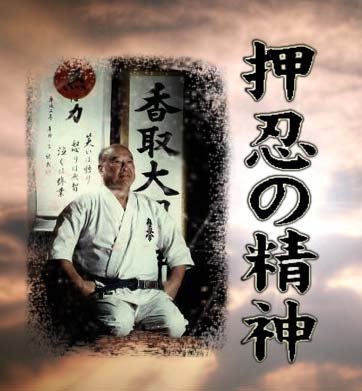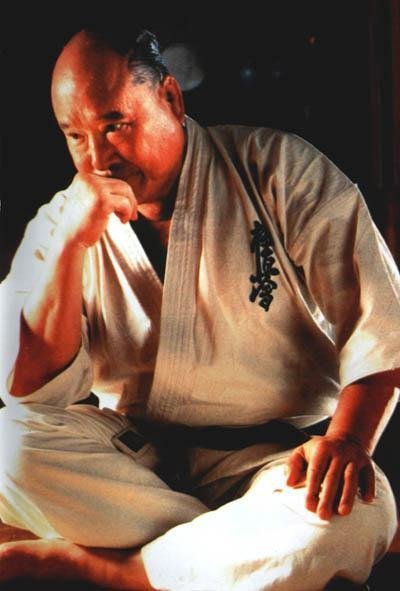HISTORY OF: KYOKUSHIN KARATE |
|
The beginning
Sosai Masutatsu Oyama was born on July 27th, 1923 and given the name Yong-I Choi. His birth place was the tiny village of Wa-Ryongri in the district of Yong-chi Myonchul Na Do, in Southern Korea. His family, considered aristocrats, and belonged to the Yangban clan. His father, Sun Hyang, was the Mayor of Kinje, a town near the village where Yong-I Choi was born. As a young child of nine years of age, whilst staying on his sister's farm in Manchuria, Oyama began studying the southern Chinese Kempo martial arts form known as "Eighteen Hands" under the instruction of Mr. Yi.
| Travelled to Japan |
In 1938 Masutatsu Oyama travelled to Japan with the desire to enter an aviation school and become a fighter pilot, but due to many reasons he was unable to enter the aviation school and was forced to abandon his dream to be a pilot and subsequently was forced to find work.
| Martial arts |
In Japan he started to practise judo, but one day the young Masutatsu Oyama saw a demonstration of Martial Arts that led him to the dojo of Gishin Funakoshi and thus, he started practicing Okinawa Karate. Ever since that day he with dedication that never wavered throughout his life Masutatsu Oyama his devoted himself to karate. By the time Masutatsu Oyama was twenty years old he had gained the rank of 4th Dan in Okinawa Karate.
| Inspiration |
Following the defeat of Japan after the Second World War, Masutatsu Oyama like all other young Japanese, was thrown into a personal crisis. He found a way out of his despair by training with So Nei Chu, a Korean Master of Goju-Ryu Karate. This great teacher, famous for the power of his body, and had a very deep spiritual belief had a profound influence Masutatsu Oyama. Master So taught him that budo and the spiritual fundamentals of Buddhism were inseparable.
| Training in the mountains |
After a few years of training, “Master So” advised Masutatsu Oyama to dedicate his life to the karate and to retreat to a mountain hideout and train both his mind and body. So in 1946, Masutatsu Oyama went into training, at a remote spot, on the Mt. Kiyosumi in. To Oyama, this was the ideal place to train and be inspired in the same tradition as his idol, Musashi. Of the books Oyama took with him on this journey, none were more important than the collection on Musashi, by Yoshikawa. For eighteen months, isolated in the mountains, Oyama tested himself against nature’s elements with such scenarios as training and meditating under icy waterfalls, performing countless jumps over bushes and boulders and using trees and rocks as A makiwara (striking aide), to condition his hands, feet and legs. He would begin training at five in the morning, running up the steep slopes. Using large rocks as weights, he would lift them hundreds of times to increase his strength. In addition, he performed kata a minimum of one hundred times each day as well as hundreds upon thousands of repetitions of kihon (basic techniques); continuously push himself to the limits of human endurance. At the conclusion of his daily training, he would read various Buddhist writings and sit in zazen and meditate. It was also at this time that Masutatsu Oyama began to contemplate the idea of the circle and point for his karate. He was accompanied by one of his students named Yashiro. His sponsor and friend Mr. Kayama brought them food supplies every month. Through hard training, Masutatsu Oyama learnt to overcome the strain caused by solitude but Yashiro could not bear it and ran away. Loneliness becomes his greatest enemy and when he and when he was at his lowest point he shaved of one eyebrow so that he could not show his face in public. In spite of his determination not to give up and return home, about fourteen months later Mr. Kayama told Oyama that he was unable to continue to support him in his quest and Oyama's original plan of remaining in solitude for three years was brought to an end.
| The bulls |
In 1950 to test his own power and to prove to himself and the world the power of karate Masutatsu Oyama began his famous battles with bulls; partly to test his strength and also to make the world sit up and notice the power of his karate. All together, Oyama fought 52 bulls, killing 3 instantly and taking the horns of 49 with knife-hand blows.
| The tour |
In 1952, Masutatsu Oyama left for USA, and he held 270 demonstrations throughout USA. During these demonstrations, he would amaze the audience with his breaking abilities and he soon got known as the GOD HAND. He also fought exhibition matches against professional boxers, wrestlers and others, and won all of them.
| The first dojo |
Masutatsu Oyama opened his first "Dojo" in 1953 in Mejiro, a suburb of Tokyo. Masutatsu Oyama's karate power was at its peak and so the training was severe. By then the influence of his martial art background, Kempo Okinawa karate and Goju karate combined to form what is known to day as “Kyokushin Karate”.
| 100 man kumite |
The Kyokushin organization has built its strength on a foundation of the fighting ability and courage and so Masutatsu Oyama, introduced a test unique only to Kyokushin Karate, the "One Hundred Man Kumite". This is considered the ultimate test in Kyokushin Karate as one has to fight 100 opponents in full contact knockdown fighting. To show that this feat could be done, Masutatsu Oyama fought 100 opponents on each of three consecutive days. He wanted to continue for a fourth day but there were no opponents left to fight.
| Bobby Lowe trains in Japan and open the first dojo outside Japan |
The first "School of Oyama" outside Japan was opened in 1957 by Shihan Bobby Lowe in Hawaii. In 1952, Masutatsu Oyama gave a demonstration in Hawaii, which was watched by Bobby Lowe. Masutatsu Oyama's powerful demonstration had amazed Bobby Lowe. So after the demonstration Bobby met with Masutatsu Oyama, and he invited Bobby Lowe to Tokyo to train with him in Japan and Bobby Lowe went to Japan and trained for over a year and a half.
| Steve Arneil trains in Japan |
Steve Arneil started training in Kyokushin after getting his Brown Belt in Judo. Steve stayed in Japan for several years and then went to England where he was invited to join British Branch Chief Robert Boulton in the British Karate Kyokushinkai instead of returning to what was then known as Rhodesia and now called Zimbabwe.
| The World Headquarters |
The building of the World Headquarters started in 1963 and was officially opened in 1964. It was at this time that Masutatsu Oyama adopted the name Kyokushin "The Ultimate Truth". Before 1963 Masutatsu Oyama had called his karate Oyama Karate. The Honbu dojo is situated in Nishi Ikebukuro, Tokyo which today is a Memorial Hall of Sosai Oyama
| The books |
In 1963 Masutatsu Oyama wrote his first book “What is Karate” which become the “karate bible” throughout the World. The book was such huge success that in 1965 he followed it up with “This is Karate” and then in 1970 with “Advanced Karate” He also wrote a large number of very successful Kyokushin books in Japanese and is no doubt the most successful author of karate book in the world.
| The spread of Kyokushin |
Kyokushin had started its spread around the globe and became the largest martial art organisations in the world with ten million members world wide
| John Taylor trains in Japan |
In April 1970 John Taylor left Australia to train at the Honbu and trains there for one year. After completing his thirty fight test in the Honbu Black belt class he was graded to 3rd Dan.
| 1975 The 1st World Open Championships |
Masutatsu Oyama amazed the world in 1975 by putting on the open first full contact championships, which had fighters from Kung Fu, Thai boxing and other karate styles. Japan Kyokushin took out all of the first eight places.
| The end |
Masutatsu Oyama passed away on April 26, 1994, at the age of 71 years. This day was a big shock for all students around the world. However, although its founder is not longer leading Kyokushin, Kyokushin members still see him as the only founder and mentor.
After Sosai Oyama died, a will alleged to be Sosai’s last Will and Testament, was produced that stated he left Kyokushin to Matsui. At the informing of all the Japanese Branch Chiefs of the existence of the will, ten Branch Chiefs refused to accept Matsui as the head of Kyokushin and immediately resigned from the then combined organisation. This created the first split in Kyokushin. These ten Japanese Branch Chiefs were Shihan Yoshikazu Matsushima, Shihan Hiroshi Masuda, Shihan Toya Watanabe, Shihan Kaoru Takagi, Shihan Tadashi Makabe, Shihan Yasuo Takahashi, Shihan Nobuhito Tezuka, Shihan Katumi Onodera, Shihan Tomokichi Anzai, Shihan Eijiro Hayashi.
Once the Japanese Branch chiefs had time to study the so called last will and testimony of Sosai Oyama, doubt was expressed regarding the authenticity of the document and another split was created and became known as IKO2 or the Branch Chiefs group, which effectively created three main Kyokushin groups. However, due to the fact that the original break-away group had not yet become an international organisation, most Kyokushin members world wide were unaware of its existence. It was latter decide by the Japanese courts that the document was not the will of Sosai Oyama.
| IKO2 |
Shihan
Nishida become the President of IKO2, but later due to a financial
scandal, Shihan Nishida, as the President, accepted responsibility
and resigned from IKO2. He then started his own organisation and
took the name of Seibukai and Shihan Sanpei became the President
of IKO2.
Later Shihan Kenji Sanpei resigned from this post (2000) due to
other commitments. After the resignation of Shihan Sanpei, Shihan
Yasuhiro Shichinohe take the leadership of the IKO2, then on June,
2001, Shihan Shichinohe resign from the IKO2 and Shihan Midori become
the President of the IKO2.
Several splits in IKO2 have occurred since its conception notable
Shihan Shichinohe, Shihan Oishi and a number of other Japanese Branch
Chiefs formed the Karate Union.
In 2003 IKO2 Japan changed their name from Kyokushin to Shinkyokushin.
At the International meeting in Japan in 2003 the Japanese IKO2
put the name change to the meeting and a number of countries also
decided to change their name to Shinkyokushin.
| History of IKO-Matsushima organisation |
In the beginning Shihan Tezuka became President of what we believe to be incorrectly named IKO3, as we were actually the first group to break away from the Matsui group. Shihan Matsushima was the vice-president.Subsequently, Shihan Tezuka resigned from his position whilst recovering from heart surgery. The Branch Chiefs at that time then chose Kancho Matsushima as the new President and the organisation took the name of IKO-Matsushima.

